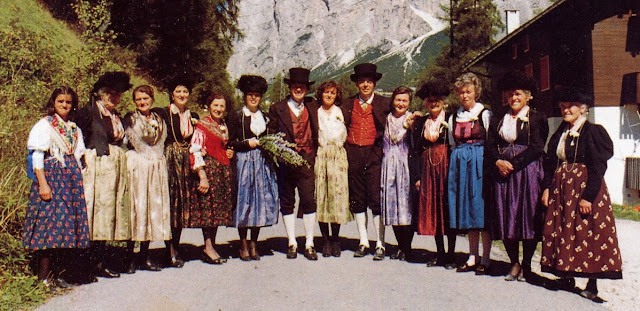Hello all,
Today I will continue to speak of the costume of the Anpezo valley. In my last post, I talked about the old costume, and mentioned that it had been revived. The folk costume of the valley had not died out but changed. The costume as worn in the latter 19th and 20th cent. comes in three forms, ra magnes, ra varnaza, and ra jaida.
Ra Magnes is the dress version of the costume. This means 'the sleeves'. This was a response to the spread in popularity of the Spencer Jacket. As a cost saving measure, leg of mutton Spencer type sleeves were often simply added to the ciamesoto. The laces in front were abandoned, and the cut of the neckline was altered. There is always a tuck in the skirt, and the hem is often protected with an added cord or facing of cloth.
Because this is a dress outfit, the bodice is ornamented with triangular pieces of satin, velvet or other rich material on the shoulders, and on the cuffs.
The kerchief around the neck was retained, but with the loss of the stomacher, it is now held in place with a silver pin. A silk or other ornate kerchief is used, tulle is the current preferred material, and it is still ornamented with ribbon and embroidery. Tulle is traditionally reserved for married women.
At this time, bloomers and corset were adopted under the influence of city fashion.
The custom of arranging the hair in braids into a bun at the nape of the neck was retained, and the hairpins became larger and fancier. A new type of pin in the shape of filligree flowers was introduced which are attached to the right side of the bun, as the ball-headed pins were attached to the left side. A married woman may wear as many floral pins as the bun will support, a single girl is restricted to one only.
A black hat is always worn with ra magnes. Originally it was ornamented only with broad silk ribbons, but an ostrich plume was added later, and gradually became larger. The ostrich feather is now considered to be obligatory.
The apron remains very full, and as long or slightly shorter than the skirt. The length of the hem varies quite a bit according to taste. The apron for ra magnes is made of silk, damask or brocade, and is closed with a silver hook and chain.
The less dressy, more everyday costume is called ra varnaza.
This retained the ciamesoto without sleeves. The chemise was replaced by a shorter blouse which was called 'fake sleeves', although generally they were attached to some sort of linen garment worn on the upper body. Often lace showed around the neck. The underskirt was of course retained. The ends of the sleeves are adorned with lace, and a ribbon is tied around the sleeves at about the elbow. Generally the hems are shorter in ra varnaza, but this also varied.
The apron remains full, and is made of plainer or richer materials according to the occasion, and is also closed with a silver hook and chain. A shawl is worn over the shoulders and over the bodice, being pinned in place on the chest. The shawl and apron must be coordinated in color and design. A hat is not worn with this costume.
There was a difference in the everyday working costume and that considered to be more presentable for Sundays and going to market.
The winter costume omits the shawl and adds a jacket with a mandarin collar. It buttons up all the way to the neck. It has a short peplum and is fitted at the waist. The style seems to be that of the late 1800's. This is called ra jaida.
Thank you for reading. I hope that you have found this interesting. I will close with some more images of this costume.You will see all four versions of the costume in the following images.
Feel free to contact me with requests for research. I hope to eventually cover all of Europe and the Former Russian Empire/Soviet Union. I also gratefully accept tips on source materials which i may not have. I also accept commissions to research/design, sew, and/or embroider costumes or other items for groups or individuals. I also choreograph and teach folk dance.
Roman K.
Source Material:
Amelia Menardi Illing, 'Il Costume in Ampezzo', Cortina, 1995
Emma Calderini, 'Il Costume Popolare in Italia', Milan, 1953
Uta Radakovich, 'Costume Tradizionali dell'AltoAdige/Suedtirol', Trento, 2009
Hans Von Hammerstein, 'Trachten der Alpenlaender', Vienna, 1937
Rudolf Fochler, 'Trachten in Oesterreich', Wels, 1980
































